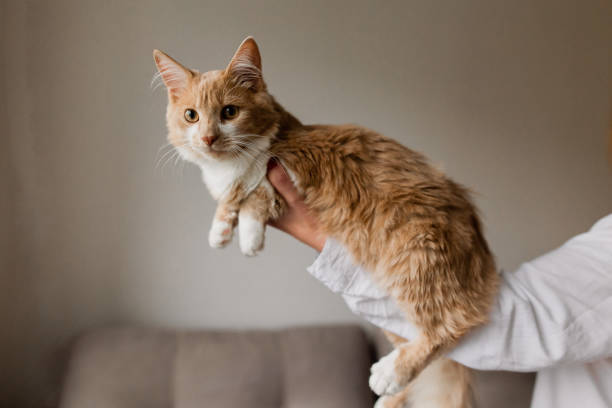
Maine Coon Cat Care: All You Need to Know
Insubordinate by nature, the cat very often “tames” us more than it allows itself to be tamed. Their education must be, therefore, a well-balanced mixture of patience, love, and cunning. The confusion of a Maine Coon’s change of address is due to its temperament of dependence on its breeder and its environment.
It is a cat that suffers from great attachment, so in the first days, even if we see it interacting calmly, we must keep in mind that it is a very stressful situation for it. In this article, you’ll learn about the general care of the largest cat breed Maine Coon, and its growth history.
The Arrival of the New Kitten
It is normal for the kitten to appear nervous upon arrival; upon arriving at its new home, the Maine Coon is a cat very dependent on its owner and very attached to its environment. Although we see him active and exploring the environment, it is a stressful situation for him, and he will not be able to adapt entirely for a week or so, even if it seems that way to us.
It is normal for the puppy to sleep many hours on the first day, especially due to the stress of the trip, and it is also completely normal for him not to eat during the first day. Some take even two days to go to the litter box to poop.
Basic Care Guide For a Maine Coon Kitten
Feeding
You should feed a Maine Coon kitten a high-end diet appropriate to each stage of its age. We recommend Royal Canin; in its different Kitten varieties, we prefer Maine Coon Kittens up to an approximate age of 2 years because the Maine Coon grows very slowly. We do not recommend, under any circumstances, another type of dry food.
We recommend mixed feed/wet food if the cat’s gastrointestinal system accepts it and does not give gas. Wet food should always be canned or packaged and away from any heat source; we recommend mainly the Animonda Kanguro variety and the variety of Animonda salmon.
Wet food should be given best at night, and only one serving. If, at any time, we realize that the kitten only expects wet food and feed intake decreases, then we will space out the feedings or mix it with the feed so that it is a complete diet since wet food is a dietary supplement.
Supplements such as malt can be used from one year of age onwards, as long as the cat sheds very abundantly, to avoid forming hairballs. In Royal Canin feeds that are Hairball variety, they can help them without needing to administer malt.
Consult with the veterinarian when the time comes. We recommend, instead of malt, white asparagus, previously washed under the tap and removing strips, not cutting. This will cause them to expel the hairs they have ingested with their feces. Catnip is also not necessary, and we do not recommend it.
Joint supplements, such as Glucosamine and Chondroitin, are not recommended until the approximate age of 1 year or one and a half, whenever necessary, and consulting with a veterinarian first.
In most cases, it is not necessary if the indicated diet is followed; the Maine Coon Kitten and British Shorthair Kitten varieties, both from Royal Canin, are supplemented so that they have strong joints.
The bowls should be large, made of glass or ceramic, never plastic, and the cat should always have food at its disposal. It should not be rationed or fed at certain times, as would be the case with dogs. These bowls should be washed and dried thoroughly, very often, to avoid bacteria.
You should always have fresh, clean water in a large glass or ceramic bowl. There are also drinking fountains, which must be kept scrupulously clean to avoid the accumulation of bacteria.
We do not recommend feeds without grains due to the gastrointestinal problems (diarrhea) that they can cause, as well as the very high protein composition, which can overload the kidneys.
On the other hand, it has been proven that this type of feed is sometimes very high in phosphorus and sodium, which can damage the kidneys and heart. In many cases, they do not have a proportionate calcium/phosphorus balance. In addition, some cases of pancreatitis caused by this diet have been reported in cats of different breeds.
Sanitary Tray and Sand
We recommend open litter trays as they are the best option. Closed litter trays can lead to stress on the animal, and they can relieve themselves outside if they are afraid or overwhelmed to enter. And it is also a space where they can accumulate bacteria and viruses on the walls. Find a tray large enough for you to feel comfortable.
The sanitary litter we recommend is SILICE SAND; we prefer this sand for its low toxicity and absence of cat allergens, in addition to being very hygienic and preventing infections. This litter should be changed when the silica stones turn yellow; a single cat can last approximately 1 week.
Under no circumstances do we recommend AGLOMERATING SAND; this sand, in addition to potentially causing cat allergies, is made up of a rubber responsible for the agglomeration. So, the sand that may accumulate on the paws and hair of cats when cats enter and leave the sandbox will be ingested due to daily grooming and can form a very dangerous blockage in their stomach or intestines.
Conclusion
There are countless cares you can offer your Maine Coon kittens to help them reach their maximum growth. Not all care is discussed in this post, so visit our website to learn more about its care. Suppose you want to learn about health care, toys, fur care, and cleaning of the eyes and ears of a Maine Coon cat. In that case, check out our webpage as we discuss anything Maine Coon at large!



